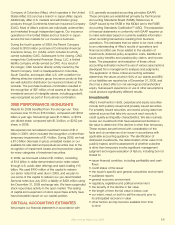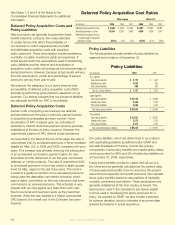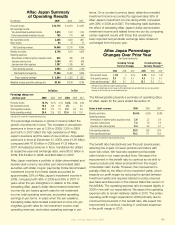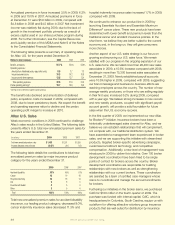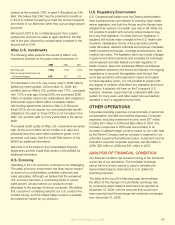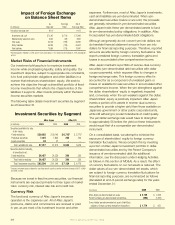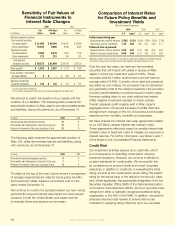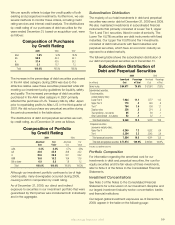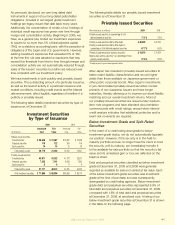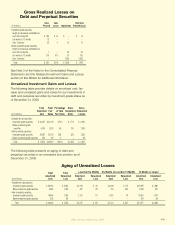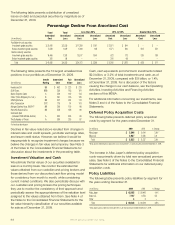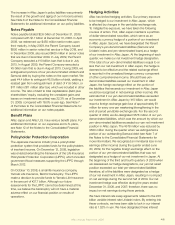Aflac 2009 Annual Report Download - page 39
Download and view the complete annual report
Please find page 39 of the 2009 Aflac annual report below. You can navigate through the pages in the report by either clicking on the pages listed below, or by using the keyword search tool below to find specific information within the annual report.
brokers at the worksite. CAIC is rated A (Excellent) by A.M.
Best. We believe that CAIC has the potential to benet us
in the U.S. market by helping us meet the product requests
and needs of our eld force when they pursue larger payroll
accounts.
We expect 2010 to be a challenging year from a sales
perspective and look for sales to again decline in the rst
half of the year, followed by modest sales increases in the
second half of 2010.
Aflac U.S. Investments
The following table presents the results of Aac’s U.S.
investment activities for the years ended December 31.
The decrease in the U.S. new money yield in 2009 reects
tightening credit spreads. At December 31, 2009, the
portfolio yield on Aac’s U.S. portfolio was 7.17%, compared
with 7.10% a year ago. During 2008, we purchased $200
million of variable interest rate collateralized debt obligations
(CDOs) that support $200 million of variable interest
rate funding agreements issued by Aac U.S. Because
these CDOs do not support our core policyholder benet
obligations, the yield on these CDOs is not included in the
Aac U.S. portfolio yield or in the yields listed in the above
table.
The overall credit quality of Aac U.S. investments remained
high. At the end of 2009, 90.4% of Aac U.S. debt and
perpetual securities were rated investment grade, on an
amortized cost basis. See the Credit Risk section of this
MD&A for additional information.
See Note 3 of the Notes to the Consolidated Financial
Statements and the Credit Risk section of this MD&A for
additional information.
U.S. Economy
Operating in the U.S. economy continues to be challenging.
The weak economic environment has likely had an impact
on some of our policyholders, potential customers and
sales associates. Although we believe that the weakened
U.S. economy has been a contributing factor to slower
sales growth, we also believe our products remain
affordable to the average American consumer. We believe
that consumers’ underlying need for our U.S. product line
remains strong, and the United States remains a sizeable
and attractive market for our products.
U.S. Regulatory Environment
U.S. Congressional leaders and the Obama administration
have expressed their commitment to enacting major health
reform legislation, and both the House and the Senate have
adopted their versions of a health care reform bill. While it is
not possible to predict with certainty what provisions may
be in any nal legislation, it is likely that such legislation, if
adopted, will include major changes to the U.S. health care
insurance marketplace. Some of the proposals currently
under discussion address individual and employer mandates,
health insurance exchanges, coverage and exclusions, and
medical loss ratios. The legislation also may include changes
in government reimbursements and subsidies for individuals
and employers and alter federal and state regulation of
health insurers. Given the substantial differences between
the legislation passed by the House and Senate, the ongoing
negotiations to reconcile the legislation and the fact that
some key provisions will be general in nature and subject
to future regulatory action, it is not possible to predict with
any degree of certainty what effect any legislation and future
regulation, if adopted, will have on the Company’s U.S.
business. However, Japan has had a national health care
system for many years, and Aac Japan has successfully
operated in such a regulated environment.
OTHER OPERATIONS
Corporate operating expenses consist primarily of personnel
compensation, benets and facilities expenses. Corporate
expenses, excluding investment income, were $77 million
in 2009, $61 million in 2008 and $56 million in 2007. The
increase in expenses in 2009 was due primarily to an
increase in realized foreign currency losses on yen cash held
by the Parent Company and an increase in expense for our
unfunded supplemental retirement plans. Investment income
included in reported corporate expenses was $9 million in
2009, $20 million in 2008 and $31 million in 2007.
ANALYSIS OF FINANCIAL CONDITION
Our nancial condition has remained strong in the functional
currencies of our operations. The yen/dollar exchange
rate at the end of each period is used to translate yen-
denominated balance sheet items to U.S. dollars for
reporting purposes.
The table at the top of the following page demonstrates
the effect of the change in the yen/dollar exchange rate
by comparing select balance sheet items as reported at
December 31, 2009, with the amounts that would have
been reported had the exchange rate remained unchanged
from December 31, 2008.
2009 2008 2007
New money yield 7.26% 7.60% 6.44%
Return on average invested assets, net
of investment expenses 6.66 6.77 6.79
Aflac Annual Report for 2009 35


